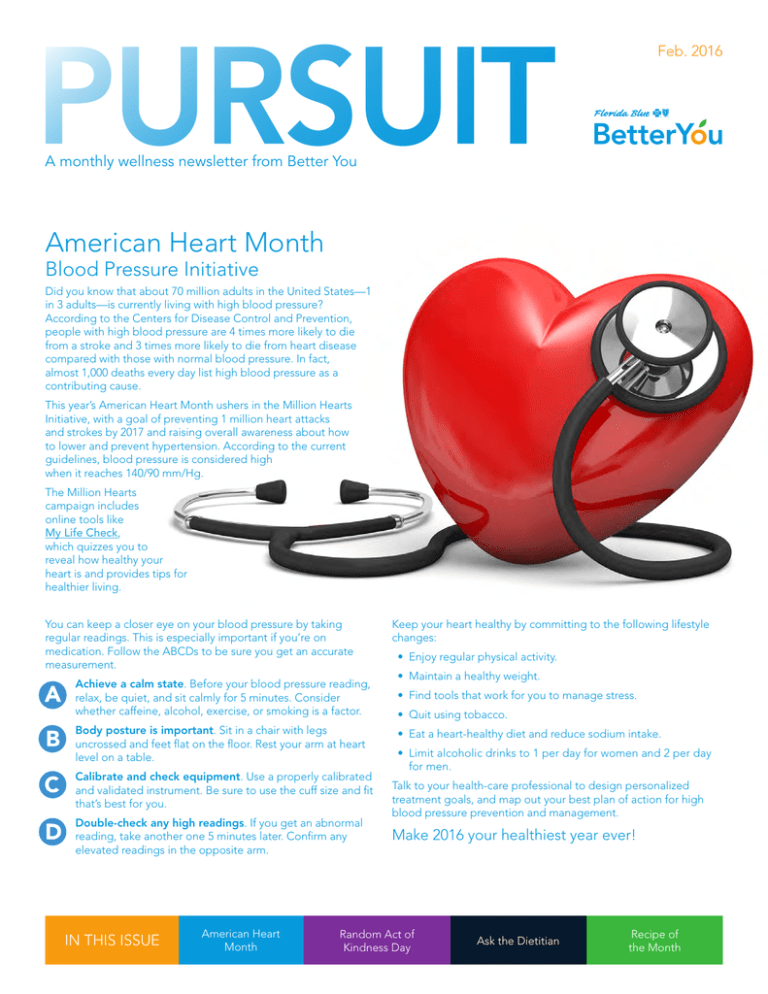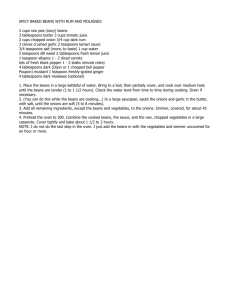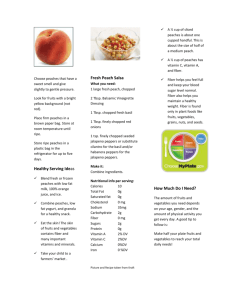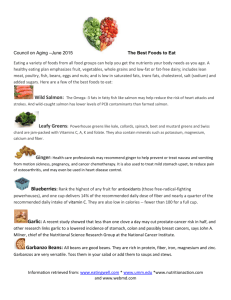PURSUIT American Heart Month Blood Pressure Initiative
advertisement

PURSUIT Feb. 2016 A monthly wellness newsletter from Better You American Heart Month Blood Pressure Initiative Did you know that about 70 million adults in the United States—1 in 3 adults—is currently living with high blood pressure? According to the Centers for Disease Control and Prevention, people with high blood pressure are 4 times more likely to die from a stroke and 3 times more likely to die from heart disease compared with those with normal blood pressure. In fact, almost 1,000 deaths every day list high blood pressure as a contributing cause. This year’s American Heart Month ushers in the Million Hearts Initiative, with a goal of preventing 1 million heart attacks and strokes by 2017 and raising overall awareness about how to lower and prevent hypertension. According to the current guidelines, blood pressure is considered high when it reaches 140/90 mm/Hg. The Million Hearts campaign includes online tools like My Life Check, which quizzes you to reveal how healthy your heart is and provides tips for healthier living. You can keep a closer eye on your blood pressure by taking regular readings. This is especially important if you’re on medication. Follow the ABCDs to be sure you get an accurate measurement. Achieve a calm state. Before your blood pressure reading, relax, be quiet, and sit calmly for 5 minutes. Consider whether caffeine, alcohol, exercise, or smoking is a factor. Body posture is important. Sit in a chair with legs uncrossed and feet flat on the floor. Rest your arm at heart level on a table. Calibrate and check equipment. Use a properly calibrated and validated instrument. Be sure to use the cuff size and fit that’s best for you. Double-check any high readings. If you get an abnormal reading, take another one 5 minutes later. Confirm any elevated readings in the opposite arm. IN THIS ISSUE American Heart Month Keep your heart healthy by committing to the following lifestyle changes: • Enjoy regular physical activity. • Maintain a healthy weight. • Find tools that work for you to manage stress. • Quit using tobacco. • Eat a heart-healthy diet and reduce sodium intake. • Limit alcoholic drinks to 1 per day for women and 2 per day for men. Talk to your health-care professional to design personalized treatment goals, and map out your best plan of action for high blood pressure prevention and management. Make 2016 your healthiest year ever! Random Act of Kindness Day Ask the Dietitian Recipe of the Month Random Acts of Kindness Day is February 17th kindness (\kīn(d)-nəs\): the quality or state of wanting and liking to do good things and to bring happiness to others. Paying for the person’s coffee in line behind you. Picking up litter that’s not yours in the park next to your house. Stopping a mom with her kids in tow at the grocery store to tell her she’s doing a good job. These random acts of kindness are encouraged all year, but on February 17 Americans officially come together to focus on doing good to those around us, especially strangers who aren’t expecting it. span across adulthood: In two large studies of older adults, Brown et al. found that those who volunteered or offered instrumental support to friends and family had a longer life span—of 5 years!—than those who did not. Other researchers have discovered that this could be because acts of service provide a sense of purpose and personal satisfaction, especially in those who are retired. Observing Random Acts of Kindness Day on February 17 is a great reminder to keep an eye out for the many opportunities we have each day to look out for each other. Use the following list as inspiration to get started: • Rake leaves for a widow or shut-in. • Give a compliment to the next three people you see. • Take a meal to a friend who’s just had a baby. According to the Random Acts of Kindness (RAK) Foundation website, individuals, or RAKtivists, should “practice kindness and pass it on to others.” Not only does this benefit those for whom we perform these good deeds, but scientists now know that it also has long-term positive effects on our health and well-being. Two studies by Otake et al. involving undergraduate students (Study 1) and women (Study 2) revealed that performing happy acts increased overall happiness within oneself, which leads to happier memories throughout life. And the positive effects of being kind to others called the “tend-and-befriend” response to protect us from some of the harmful effects of stress during fight-or-flight responses. • Take a care package with bottled water, granola bars, and baby wipes to someone without a permanent residence. • Pay the toll for the car behind you on the highway. When we are kind to others, a hormone called oxytocin is released and has been shown to help us establish trusting relationships and feel connected in groups. Indeed, oxytocin may be connected to both physical and emotional well-being. It is released in what has been • Leave a kind note on a coworker’s computer while he or she is away. Remember: Kindness is contagious! Ask the Dietitian: Q. How can I add more fiber to my day? A. Most of us don’t get the recommended amount of fiber in our diets each day: 25 grams for women and 38 grams for men. Good sources of fiber come from fruits and vegetables, beans and legumes, whole grains and nuts and seeds. Here are some ways to add more fiber to each meal: 1. Breakfast – Add 1/2 cup of raspberries, strawberries or blueberries to your cereal or yogurt. Make your cereal a bran cereal, steel-cut oatmeal or a brand with at least 5 grams of fiber per serving. Eat a banana or have an orange instead of orange juice. 2. Lunch – Have a spinach salad and top it with beans. All beans (navy, kidney, white, black) are excellent sources of fiber. Chickpeas, edamame and lentils are also good choices. Make a vegetarian chili with a few different kinds of beans and vegetables. If you take a sandwich for lunch, use whole-grain bread, and top it with slices of avocado. 3. Snacks – Eat an apple or a pear with the skin on, or grab a handful of nuts or seeds (e.g., almonds, pistachios, sunflower seeds, pumpkin seeds). Don’t forget air-popped popcorn! 4. Dinner – Dark-colored vegetables (e.g., artichokes, green peas, collard greens, Swiss chard, broccoli, Brussels sprouts, beets) make a great side dish. Try brown rice, wild rice, quinoa or barley, and eat your potato with the skin on! It’s best to get your fiber from food sources and to add it to your diet gradually. A higher fiber diet helps with regularity, packs a nutrient punch and protects against chronic diseases like heart disease, type 2 diabetes and some cancers. FEB 2016 2 Fresh and Healthy Recipe of the Month Hearty Turkey Chili This chili uses roasted vegetables and turkey meat instead of ground beef for a full, hearty flavor. Serves 8 Ingredients: • 2 cups chopped zucchini • 1 teaspoon olive oil • 1 cup chopped onion PHOTO COURTESY: MAYOCLINIC.ORG • 2 cups chopped celery • 1 cup chopped bell peppers • 2 teaspoons chopped fresh garlic • 1 pound chopped cooked turkey • 1 1/2 tablespoons chili powder • 1 teaspoon cumin seed • 2 cups diced canned tomatoes, no-salt-added variety • 4 cups canned kidney beans, rinsed and drained • 2 cups low-sodium vegetable broth • 1 teaspoon brown sugar Directions: 1. Preheat the oven to 475 F. Spray a glass baking dish with cooking spray. Arrange the zucchini in a single layer in the baking dish. Roast for 8 to 10 minutes until slightly tender and lightly browned. 2. W hile the zucchini is roasting, add the oil and chopped onions to a Dutch oven or soup pot. Sauté over low heat until the onions are brown. Add the celery and peppers and continue to sauté. Add garlic, turkey, chili powder and cumin seed. Cover and simmer for about 5 minutes. 3. S tir in the tomatoes, kidney beans, vegetable broth, brown sugar and the roasted zucchini. Cover and simmer for 15 minutes. Ladle into warmed individual bowls. Serve immediately. Nutrition: Serving size: About 1 1/2 cups. Calories 252; Total fat 4 g; Saturated fat 1 g; Trans fat Trace; Monounsaturated fat 2 g; Cholesterol 57 mg; Sodium 178 mg; Total carbohydrate 28 g; Dietary fiber 8 g; Sugars 0.5 g; Protein 26 g. Recipe courtesy of MayoClinic.com Florida Blue is a trade name of Blue Cross and Blue Shield of Florida, Inc., an Independent Licensee of the Blue Cross and Blue Shield Association. All materials, content and forms contained in this newsletter are the intellectual property of Better You and may not be copied, reproduced, distributed or displayed in full or in part without expressed written permission by Better You. 85758 0216 FEB 2016 3



